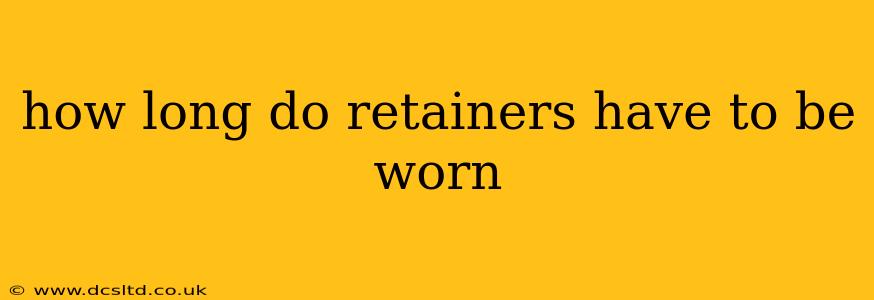How Long Do Retainers Have to Be Worn? A Comprehensive Guide
The length of time you need to wear a retainer depends on several factors, making it a question with no single definitive answer. While some individuals might only need to wear them for a few months, others may require lifelong use. This guide breaks down the crucial factors influencing retainer wear time and answers common questions about this essential part of orthodontic treatment.
Understanding the Purpose of Retainers
Retainers are crucial after braces or other orthodontic appliances are removed. Their primary purpose is to maintain the straightness and alignment of your teeth achieved through orthodontic treatment. Without retainers, teeth naturally tend to shift back to their original positions over time, negating the results of the orthodontic work. This process is called relapse.
How Long Do I Need to Wear My Retainer After Braces?
This is the most frequently asked question, and the answer is nuanced. Your orthodontist will provide a personalized plan based on:
- Severity of the initial misalignment: More severe cases often require longer retainer use to prevent relapse.
- Age: Younger individuals tend to have more flexible bone and tissue, increasing the risk of relapse and necessitating longer retainer wear.
- Compliance: Consistent retainer use is key. Inconsistent wear increases the chances of relapse and necessitates prolonged use.
- Type of retainer: Different retainers have varying effectiveness and recommended wear schedules.
What Are the Different Types of Retainers, and How Long Should Each Be Worn?
Several types of retainers exist, each with its own recommended wear schedule:
-
Fixed (bonded) retainers: These are cemented to the back of your teeth and are worn indefinitely. They are usually inconspicuous and require minimal maintenance, but they can sometimes break or need adjustments.
-
Removable retainers (Essix, Hawley): These are the most common types.
- Initial phase: Your orthodontist will likely recommend wearing them 20-22 hours a day for the first 6-12 months. This intensive phase is crucial to solidify the results of your orthodontic treatment.
- Long-term phase: After the initial phase, the wear time gradually decreases. Some individuals might only need to wear them at night, while others might require continued daytime wear, depending on their individual needs and their teeth's tendency to shift.
What Happens if I Don't Wear My Retainer as Prescribed?
Failing to wear your retainer as directed can lead to:
- Relapse: Your teeth will gradually shift back to their pre-treatment positions, undoing the results of your orthodontic treatment.
- Crowding: Teeth may become crowded and misaligned.
- Overbite/Underbite issues: Problems with your bite can re-emerge.
- Difficulty chewing and speaking: Your bite issues could affect your ability to chew or speak properly.
How Often Should I See My Orthodontist After Treatment?
Regular checkups with your orthodontist are crucial, even after you finish your orthodontic treatment. Your orthodontist will monitor your progress and make any necessary adjustments to your retainer or treatment plan as needed. This typically involves scheduling follow-up appointments every few months for the first year, then possibly less frequently.
Can I Stop Wearing My Retainer Completely?
For most people, the answer is no, not permanently. While you may eventually transition to wearing your retainer only at night or even less frequently, completely discontinuing its use usually leads to relapse. The decision to reduce or stop wearing a retainer should be made in consultation with your orthodontist.
Conclusion:
The duration of retainer wear is highly individualized. Strict adherence to your orthodontist's recommendations is crucial for preserving the results of your orthodontic treatment. Regular checkups and open communication with your orthodontist are key to maintaining a healthy, straight smile for years to come. Remember, your orthodontist is the best resource for determining your specific needs and timeline for retainer use.
